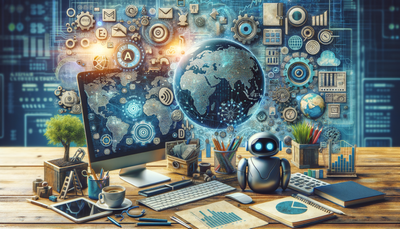Implementing AI Chatbots for Multi-Language Support on Your Website
In today's globalized digital landscape, providing multilingual customer support is crucial for businesses aiming to expand their reach and enhance user experience. AI-powered chatbots offer an innovative solution to this challenge, enabling websites to communicate with visitors in multiple languages seamlessly. This article explores the implementation of AI chatbots for multi-language support, focusing on key aspects such as language detection, real-time translation, and cultural adaptation techniques. By leveraging these advanced technologies, businesses can offer personalized, efficient, and culturally appropriate support to their international audience, ultimately improving customer satisfaction and driving growth in diverse markets.Table of Contents:

The importance of multilingual customer support
As businesses expand their online presence globally, the need for effective multilingual customer support becomes increasingly critical. Customers expect to interact with brands in their native language, and failure to meet this expectation can result in lost opportunities and diminished customer satisfaction. AI-powered chatbots offer a scalable and cost-effective solution to this challenge, allowing websites to provide instant support in multiple languages without the need for a large team of human agents. By implementing multilingual chatbots, businesses can break down language barriers, improve customer engagement, and create a more inclusive user experience for their diverse audience. Do you need a website? Want to build a website but don't know where to start? Our website builder is the perfect solution. Easy to use, and with the ability to customize to fit your business needs, you can have a professional website in no time.
Language detection: The first step in multilingual support
Effective multilingual support begins with accurate language detection. AI-powered chatbots use sophisticated algorithms to identify the language of incoming user queries, enabling them to respond appropriately. These algorithms analyze various factors, including the text content, character sets, and even user location data to determine the most likely language being used. Advanced language detection systems can distinguish between similar languages and dialects, ensuring a high level of accuracy. By implementing robust language detection, chatbots can automatically switch to the appropriate language, creating a seamless and personalized experience for users from different linguistic backgrounds.Real-time translation: Bridging the language gap
Once the user's language is detected, AI chatbots leverage real-time translation capabilities to facilitate smooth communication. These translation engines use advanced natural language processing (NLP) and machine learning techniques to convert text between languages accurately and instantly. The quality of translations has improved significantly in recent years, with AI models capable of understanding context and nuances to provide more natural and coherent translations.To implement real-time translation in chatbots, businesses can integrate third-party translation APIs or develop their own custom translation models. It's essential to regularly update and fine-tune these translation engines to ensure optimal performance and accuracy across various language pairs.
Building a website with SITE123 is easy
Cultural adaptation: Beyond literal translation
Effective multilingual support goes beyond mere translation; it requires cultural adaptation to ensure that the chatbot's responses are appropriate and relevant to users from different cultural backgrounds. This involves considering factors such as idiomatic expressions, cultural references, and communication styles specific to each language and region.To achieve cultural adaptation, businesses should invest in localization efforts, working with native speakers and cultural experts to refine the chatbot's responses. This may include adapting greeting styles, using appropriate honorifics, and tailoring product recommendations or support solutions to align with local preferences and customs. By incorporating cultural nuances, chatbots can provide a more authentic and relatable experience for users across different cultures.
Training and continuous improvement
Implementing multilingual AI chatbots is an ongoing process that requires continuous training and improvement. As chatbots interact with users in various languages, they accumulate valuable data that can be used to enhance their performance. Regular analysis of chat logs and user feedback helps identify areas for improvement, such as misunderstandings, translation errors, or culturally inappropriate responses.Businesses should establish a feedback loop that involves human reviewers who can assess the quality of chatbot interactions and make necessary adjustments. This human-in-the-loop approach ensures that the AI system continues to learn and adapt to the evolving needs of multilingual users. Additionally, staying up-to-date with advancements in NLP and machine translation technologies is crucial for maintaining a competitive edge in multilingual customer support.
Integration with existing systems
To maximize the effectiveness of multilingual AI chatbots, it's essential to integrate them seamlessly with existing customer support systems and workflows. This integration allows for a smooth handover to human agents when necessary and ensures consistency in customer data across different touchpoints.Consider integrating the chatbot with your customer relationship management (CRM) system, knowledge base, and ticketing system. This enables the chatbot to access relevant customer information and provide personalized support across languages. Additionally, implement analytics tools to track key performance indicators (KPIs) such as customer satisfaction, resolution rates, and language preferences, allowing you to continually optimize your multilingual support strategy.





